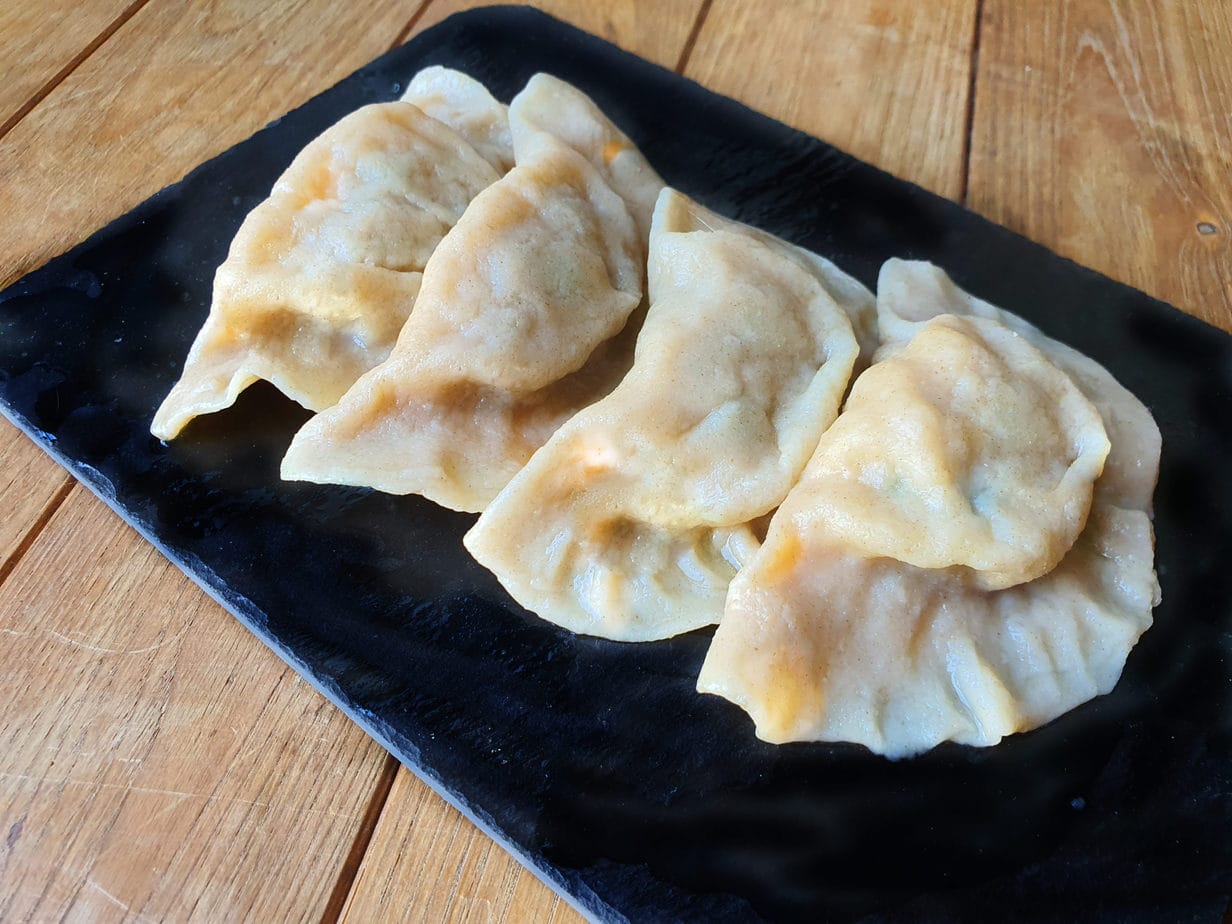
Servings: 4 servings
Calories: 745kcal
Ingredients
Seasoned Oil
- 350 ml peanut oil
- 100 g spring onions
- 50 g celery preferably Chinese celery
- 0.25 onion
- 4 cloves garlic
- 1 piece of ginger about 3 cm
- 0.5 cinnamon stick Chinese
- 2 star anise
- 0.25 teaspoon fennel seeds
Infused Water
- 0.5 tablespoon Sichuan peppercorns
- 1 piece crushed ginger about 3 cm
- 160 ml water
Cabbage
- 300 g Chinese cabbage
- 1 teaspoon salt
Filling
- 300 g ground pork preferably belly, at least 30% fat
- Infused water, prepared in advance
Pork Seasonings
- 1 teaspoon salt
- 1 teaspoon Chinese five-spice
- 1 teaspoon chicken bouillon powder
- 1 teaspoon cornstarch
- 1 teaspoon light soy sauce
- 1 teaspoon Shaoxing wine
Finishing Oil
- 2 tablespoons seasoned oil
- 1 teaspoon toasted sesame oil
Dough
- 252 g wheat flour at least 10% protein
- 141 ml water
- 1.2 g salt
Procédé
Dough
- Mix the salt and flour.252 g wheat flour, 1.2 g salt
- Using a fork, add the water little by little. Knead for 3-4 minutes.141 ml water
- Cover and let rest for 10 minutes.
- The dough should now be much smoother. Knead for 1 minute.
- Cover while you prepare the filling.
Seasoned Oil
- Soak the spices in water for about 10 minutes before cooking to prevent them from burning.0.5 cinnamon stick, 2 star anise, 0.25 teaspoon fennel seeds
- Roughly chop the remaining ingredients.100 g spring onions, 50 g celery, 0.25 onion, 4 cloves garlic, 1 piece of ginger
- Gently fry the chopped aromatics and soaked spices in the oil over medium heat. This will take about 20 minutes. The onion should just begin to brown; stop before it turns golden.350 ml peanut oil
- Pour everything into a bowl while still hot, then cover. Let infuse for 1 hour, or preferably overnight.
- The next day, strain to remove the spices and aromatics.
Infused Water
- Bring the water to a boil.160 ml water
- Pour it into a bowl with the ginger and Sichuan peppercorns.1 piece crushed ginger, 0.5 tablespoon Sichuan peppercorns
- Infuse for about 30 minutes. Strain and let cool.
Cabbage
- Finely chop the Chinese cabbage.300 g Chinese cabbage
- In a mixing bowl, toss with the salt and let rest for 10-15 minutes.1 teaspoon salt
- Squeeze out the liquid, then transfer to cheesecloth and squeeze again to remove more. Set aside.
Filling
- Mix the seasonings with the pork. Always stir in the same direction.1 teaspoon salt, 1 teaspoon Chinese five-spice, 1 teaspoon chicken bouillon powder, 1 teaspoon cornstarch, 1 teaspoon light soy sauce, 1 teaspoon Shaoxing wine, 300 g ground pork
- Gradually pour in the infused water while stirring constantly in the same direction. The water addition should take about 3-5 minutes. The pork should become slightly sticky.Infused water, prepared in advance
- Just before forming the dumplings, combine the cabbage with the pork mixture.
- Add the finishing oil.2 tablespoons seasoned oil, 1 teaspoon toasted sesame oil
Cooking
- Flatten the dough by hand into a thick disc, then cut into 4 pieces.
- Roll each piece to about 2 cm thick.
- Cut into 2 cm-long pieces (or 10-12 g).
- Dust the pieces you aren't using right away with flour and keep covered.
- Flatten to form discs, then roll out with a rolling pin.
- Fold the dumplings much like classic ravioli; there aren't really pleats as with gyoza. Seal well so they're sturdy.
- To cook, add the dumplings to boiling water, then cover.
- As soon as the water returns to a boil, add about 150 ml of cold water.
- Let the dumplings return to a boil.
- Repeat once more, adding cold water and letting it return to a boil, then remove from the heat and drain.
- You can also steam them for 15 minutes.
Notes
Vary the size of your wrappers to your liking. If you have filling left over, feel free to freeze it for later use.
You'll likely have seasoned oil left over—make more dumplings, or use it to stir-fry noodles, rice, etc.
Nutrition
Calories: 745kcal | Féculents: 81g | Protein: 32g | Fat: 31g | Saturated Fat: 11g | Polyunsaturated Fat: 4g | Monounsaturated Fat: 13g | Cholesterol: 90mg | Sodium: 964mg | Potassium: 481mg | Fiber: 3g | Sugar: 1g | Vitamin A: 9IU | Vitamin C: 1mg | Calcium: 37mg | Iron: 6mg
As-tu réalisé cette recette ?Tague @marcwiner sur Instagram !